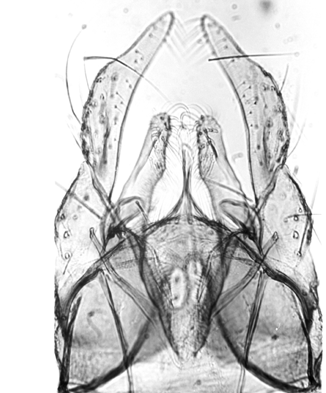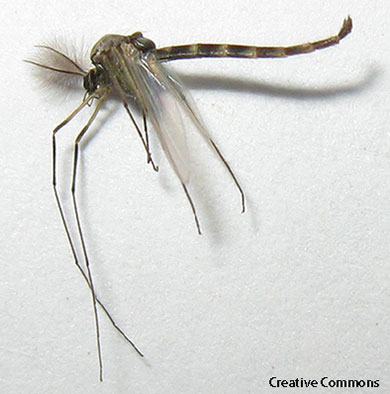Species e. C. melanescens Keyl, 1962 Keyl attributes the species to Strenzke, but Strenzke did not publish any description.
Chironomus melanescens Keyl, 1961 - nomen nudum with no description. The Nearctic specimens are in BOLD BIN: BOLDAAI4303
The nearest neighbor Bin: BOLD:AAS1281 is also identified as C. melanescens, but from the Palearctic - Norway, Bulgaria and Russia.
These results suggest that the status of the specimens from the two areas may need to be reconsidered. They represent subspecies at the very least.Adult:
Male:
Comparison to characters of Palearctic specimens (in brackets) where these are available from Wülker et al. (1981):
Wing length 3.76 (3.42-4.66) mm, width 0.98 mm. AR 3.7 (3.20-4.58). LR 1.52 (1.42-1.58), Fe1/Ti1 1.05 (1.00-1.11); BR 2.0-2.2 (1.5-3.0).Additional data from Nearctic male:
Length/width of frontal tubercles 22 x 10 µm; palpal proportions (micron) 53 :53 : 227 : 255 : 353; P5/P4 1.39-1.40; P5/P3 1.49-1.54. 43-44 clypeal setae.
Thoracic setae: acrostichals at least 13; dorsolaterals 21-43; prealar 5-6; supraalar 1-2, scutellars in approximately three rows, posterior row with 18-19 setae, other two rows less clear and with 25-26 setae between them (total 44).
Three SCf on branchiolum of wing, 26-27 setae in squamal fringe.
Leg proportions (microns):
| Fe
| Ti
| Ta1
| Ta2
| Ta3
| Ta4
| Ta5
| LR
| F/T
| BR
| PI
| 1395
| 1325
| 2030
| 995
| 825
| 757
| 365
| 1.52-1.54
| 1.05
| 2.0-2.5
| PII
| 1455
| 1395
| 875
| 500
| 360
| 250
| 160
| 0.63-0.64
| 1.04-1.05
|
| PIII
| 1700
| 1742
| 1345
| 740
| 578
| 330
| 195
| 0.76-0.78
| 0.97
|
|  
Male terminalia of C. melanescens (left) and whole adult (from BOLD Database)(right). Abdomen showing the pattern of coloration (below). 
Abdominal tergites with basal brown bands, but extending further along the tergite in the more posterior segments. Nine (4-16) setae in center of tergite IX, 1 or 2 to a pale patch (see above).
Hypopygium as that of European specimens of C. melanescens in being similar to that of C. riparius Meigen, 1804, with a narrow anal point and a superior volsella of the S-type of Strenzke (1959). Inferior volsella reaching beyond end of anal point about to midpoint of the gonostylus, with simple setae. Gonostylus moderately swollen and tapers relatively gradually from about two thirds along its length.Female - no information available. Pupa typical of the genus, lightish brown in color. Length about 8.2-8.3 mm, posterior margin of wing case 3.4-3.5 mm. Cephalic tubercles about 46-68 µm in length, slightly longer than their basal diameter. Lacking frontal warts and secondary tubercles.
Basal ring of respiratory organ abt 56 x 48 µm; HR about 1.17-2.61; respiratory fibres very narrowed in the middle.
About 51-73 recurved hooks on posterior margin of segment II, hook row approximately half of width of the segment. Light shagreen pattern particularly near the centerline towards the rear of the segments, small muscle marks on segments I-III; obvious pedes spurii B on segment II and large pedes spurii A on segment IV (about 164 x 101 µm and about 0.19 of segment length); smaller PSA of spines on segment V (abt 88 x 50 µm) and also on segment VI (abt 75 x 38 µm).
Posterolateral spurs of segment VIII with 1-2 spines. Anal lobe fringe with about 75-77 filamentous taeniae on each side, initially in a single row, but increasing to a triple row near the posterior end. Fourth instar larva a medium sized (length, female abt 14.2 (13.0-16.5 mm, male 10.3 mm) bathophilus-type with ventral tubules (VT) of almost equal length (ant. 1.55 (0.8-2.75) mm; post. 1.64 (0.8-2.73) mm), anal tubules (AT) (Fig. g) long, about 6 times longer than wide. However these measures differ between the Ontario and Wisconsin specimens, with the Wisconsin specimens having longer VT and shorter AT. Ventral head length about 414.5 (378-448) µm.
Gular region pale to slightly dark on posterior third, frontoclypeus pale to slightly darkened. Salivary reservoir long and narrow, 94-140 µm wide and 15-23 µm deep (L/W abt 5.8 (5.2-6.9)).
Mentum (Fig. c) abt 0.48-0.55 of VHL, with pointed teeth; 4th laterals hardly reduced (type I); c1 tooth long and narrow with c2 teeth well separated (type III).
Ventromentum (Fig. d) with about 39.4 (37-43) not very obvious striae, VMR about 0.35-0.41. Pecten epipharyngis (Fig. a) with about 14.5 (13-16) sharp teeth, although the Clarence Creek specimens were distorted and irregular.
Premandible (Fig. b) with broad teeth about equally long, unless outer more worn, inner tooth about 2.9 (2.3-4.2) times the width of outer tooth (Ty. C).
Antenna (Fig. e) with relatively long, narrow basal segment, about 0.44 (0.43-0.45) of VHL, abt. 4 (3.9-4.2) times as long than wide; ring organ between a quarter and half way from base of A1 (0.23-0.46); AR about 2.19 (1.88-2.41); A1/A2 abt 3.9-4.6; ratio of segments (in microns) about 184 ; 42 : 12.5 : 14.5 : 9.
Distance between antennal bases (175-223 µm) greater than that between the S4 setae (158-205 µm).
Mandible (Fig. f) about 290 (276-311) µm long, with 3rd inner tooth only slightly darkened and partly to nearly completely separated (type II-IIIB), and with about 12.7 (11-14) furrows on the outer surface at the base and 11 (10-13) taeniae in PecM. Cytology: 4 polytene chromosomes with pseudothummi arm combination AE, BF, CD, G.
Arm G generally paired unless heterozygous, with a subterminal nucleolus and 2 Balbiani rings which vary in position depending on the sequence. No nucleoli in other arms.
Polymorphic at least in arms A, C, and G, as in Palearctic populations, but not necessarily the same inversions. h'melA1: 1 - 2c, 10 - 12, 3i - 2d, 9 - 4, 13 - 19; ie. as holomelas (Holarctic)
melA2: 1 - 2c, 10 - 12, 3i - 2d, 16 - 13, 4 - 9, 17 - 19 (Nearctic)
melB1: Typical puff (group 7) approximately medial (Palearctic)
melB2: Typical puff (group 7) near centromere (Nearctic)
h'melC1: 1 - 2f, 11c - 10, 16 - 17a, 7d-a, 13 - 11d, 2g - 6, 14 - 15, 8 - 9, 17b - 22. (Holarctic)
melC2: 1 - 2f, 11c - 10, 16 - 17a, 9 - 8, 15 - 14, 6 - 2g, 11d - 13, 7a-d, 17b - 22 (Palearctic)
melC3: not mapped, but distal break closer break closer to end of arm (Nearctic)
melD1: 1a-e, 9 - 7, 13c - 10, 1f - 6, 13d - 16, 19e - 23, 19h - 17, 24.
Nearctic sequence not clear but central region may be inverted c/f Palearctic sequence
h'melE1: 1a-d, 3f - 11, 1e - 3e, 12 - 13 (Holarctic)
melF1: 1 - 4b, 15f - 4c, 15g - 23 (Holarctic)
h'melG1: Subterminal nucleolus and 2 nearby BRs. (Holarctic)
melG2: simple inversion near distal end of arm. (Palearctic)
melG3: simple inversion of medial section of arm. (Palearctic)
mlsG4: Simple inversion of region between BRa and BRb to near distal end (Nearctic)Molecular Data: Sequence for mitochondrial COI and CytB of Palearctic material are available in GenBank (accession numbers AF192204, AF192173) and COI of numerous NA specimens is available in GenBank and BOLD. Barcode sequences of Palearctic specimens differ by 13 bases from those of the Nearctic specimens (below). This suggests they should be considered to be at least subspecies: base
Nearctic
T A G A T A C T T G T T C
Palearctic
A T A G C G T C G A A C A/T Palearctic form: C. melanescens melanescens
Nearctic form: C. melanescens parais
Note: 'parais' is an early name for North America Found: Alberta – Jasper National Park (53.192°N, 65.22°W) (BOLD)
Ontario – Clarence Creek (45.50°N, 75.22°W), Russell Co.; Dunrobin (45.45°N, 76.00°W), Carleton Co.; Blair Rd Public School,
Cambridge (43.3718°N, 80.327°W) (BOLD BIOUG13119-C10); rare Charitable Research Reserve (43.3705°N, 80.3641°W),
Cambridge. (Telfer et al. 2015); Howick Central Public School, Gorrie (43.884°N, 81.053°W) (BOLD BIOUG13107-G1); Saunders
Secondary School, London (42.947°N, 81.289°W) (BOLD BIOUG13007-E01); Notre Dame Catholic School, Orillia (44.61°N,
79.461°W) (BOLD BIOUG13120-A02); Thousand Islands Natl. Park (44.453°N, 75.865°W) (BOLD BIOUG20486-E04); Toronto Zoo,
Rouge National Urban Park (43.822°N, 79.19°W), Toronto (BOLD BIOUG20014-G11).
Prince Edward Island - Cavendish Grove, Prince Edward Island Natl. Park (46.493°N, 63.394°W) (BOLD BIOUG20330-B12).
Saskatchewan – Grasslands National Park (49.001°N, 106.557°W) (BOLD)
Wisconsin – Arboretum, Madison (43.03°N, 89.42°W), Dane Co.; Trout Lake Limnol. Stn. 41.02°N, 89.67°W), Vilas Co.
Germany: Clausthal (Zellerfeld)(locality of type ) and Duemmer Lake.
Switzerland and Russia. Temporary pools, especially snow melt pools. Adults and larvae partly described by Wülker et al. (1981), who also described the cytology, and Kiknadze et al. (1991) illustrated the larva and redescribed and cytology (with minor errors in arm E); Kiknadze & Broshkov (2009) redescribe the cytology of European and Asian specimens. Martin (2015) describes morphology, karyotype and Barcode of North American specimens. See also C. sp. z, C. sp. 2t, C. sp. 3l.| Return to Index ] |


